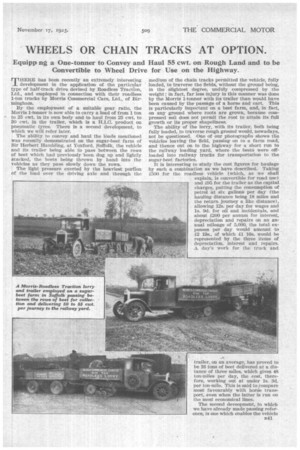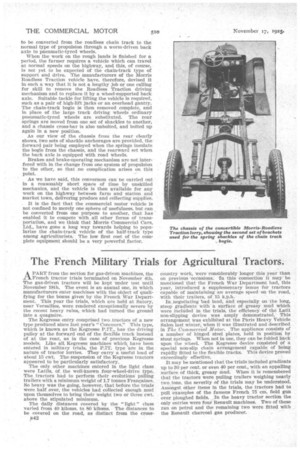WHEELS OR CHAIN TRACKS AT OPTION.
Page 25

Page 26

If you've noticed an error in this article please click here to report it so we can fix it.
Equipp ng a One-tonner to Convey and Haul 55 cwt. on Rough Land and to be Convertible to Wheel Drive for Use on the Highway.
THERE has been recently an extremely interesting development in the application of the particular type of half-track drive devised by Roadless Traction, Ltd., and employed in connection with their roadless 1-ton trucks by Morris Commercial Cars, Ltd., of Birmingham.
By the employment of a suitable gear ratio, the Morris 1-tonner is now able to carry a load of from 1 ton to 25 cwt. in its own body and to haul from 25 cwt. to 30 cwt. in the trailer, Which is a B.LC. product on pneumatic tyres. There is a second development, to which we will refer later.
The ability to convey and haul the loads mentioned was recently demonstrated on the sugar-beet farm of Sir Herbert Rambling, at Yoxford, Suffolk, the vehicle and its trailer being able fo pass between the rows a beet which had previously been dug up and lightly stacked, the beets being thrown by hand into the vehicles as they pass slowly down the rows.
The light pressure exerted by the heaviest portion of the load over the driving axle and through the medium of the chain tracks permitted the vehicle, fully loaded, to traverse the fields, without the ground being, in the slightest degree, unduly compressed by the weight ; in fact, far less injury in this manner was clone by the Morris 1-tonner with its trailer than would have been caused by the passage of a horse and cart. This is particularly important on a beet farm, and, in fact, on any ground where roots are grown, because compressed soil does not permit the root to attain its full growth or its proper shapeliness.
The ability of the lorry, with its trailer, both being fully loaded, to traverse rough ground would, nowadays, not be questioned. One of our photographs shows tfie vehicles leaving the field, passing on to a farm road, and thence out on to the highway for a short run to the railway loading yard, where the beets were offloaded into railway trucks for transportation to the sugar-heet factories.
It is interesting to study the cost 'figures for haulage by such a combination as we have described. Taking £500 for the roadless vehicle (which, as we shall explain, is convertible for road use) and £95 for the trailer as the capital charges, putting the consumption of petrol at six gallons per day (the hauling distance being 18 miles and the return journey a like distance), allowing 12s. per day for wages and Is. 9d. for oil and incidentals, and about 1200 per annum for interest, depreciation and repairs on an annual mileage of 5,000, the total expenses •per day would amount to
£2 19s., of which 16s. would be represented by the three items of depreciation, interest and repairs. A day's work for the truck and trailer, on an average, has proved to be 10 tons of beet delivered at a distance of three miles, which gives 48 ton-miles per day, the cost, therefore, working out at under is. 3d. per ton-mile. This is said to ,Compare most favourably with horse transport, even when the latter is run on the most economical lines.
The second deveopment, to which we have already made passing reference, is one which enables the vehicle n41 to be converted from the roadiess chain track to the normal type of propulsion through a worm driven back axle to pneumatic-tyred wheels.
When the work on the rough lands is finished for a period, the farmer requires a vehicle which can travel at normal speeds on the highway, and this, of course, is not yet to be expected of the chain-track type of support and drive. The manufacturers of the Morris Roadless Traction vehicle have, therefore, devised it in such a way that it is not a lengthy job or one calling for skill to remove the Roadless Traction driving mechanism and to replace it by a wheel-supported back axle. Suitable tackle for lifting the vehicle Is required, such as a pair of high-lift jacks or an overhead gantry.
The chain-track bogie is then removed complete, and in place of the large track driving wheels ordinary pneumatic-tyred wheels are substituted. The rear springs are moved from one set of shackles to another, and a chassis cross-bar is also unbolted, and bolted up again in a new position.
As our view of the chassis from the rear clearly shows, two sets of shackle anchorages are provided, the forward pair being employed when the springs insulate the bogie from the chassis, and the rearward set when the back axle is equipped with road wheels.
Brakes and brake-operating mechanism are not interfered with in the change from one system of propulsion to the other, so that no complication arises on this point.
As we have said, this conversion can be carried out in a reasonably short space of time by unskilled mechanics, and the vehicle is then available for any work on the highway between farm and station and market town, delivering produce and collecting supplies.
. It is the fact that the commercial motor vehicle is not confined to merely one sphere of usefulness, but can be converted from one purpose to another, that has • enabled it to compete with all other forms of transportation, and we think that Morris Commercial Cars, Ltd., have gone a long way towards helping to popularize the chain-track vehicle of the half-track type among agriculturiata. The low first cost of the complete equipment should be a very powerful factor.
































